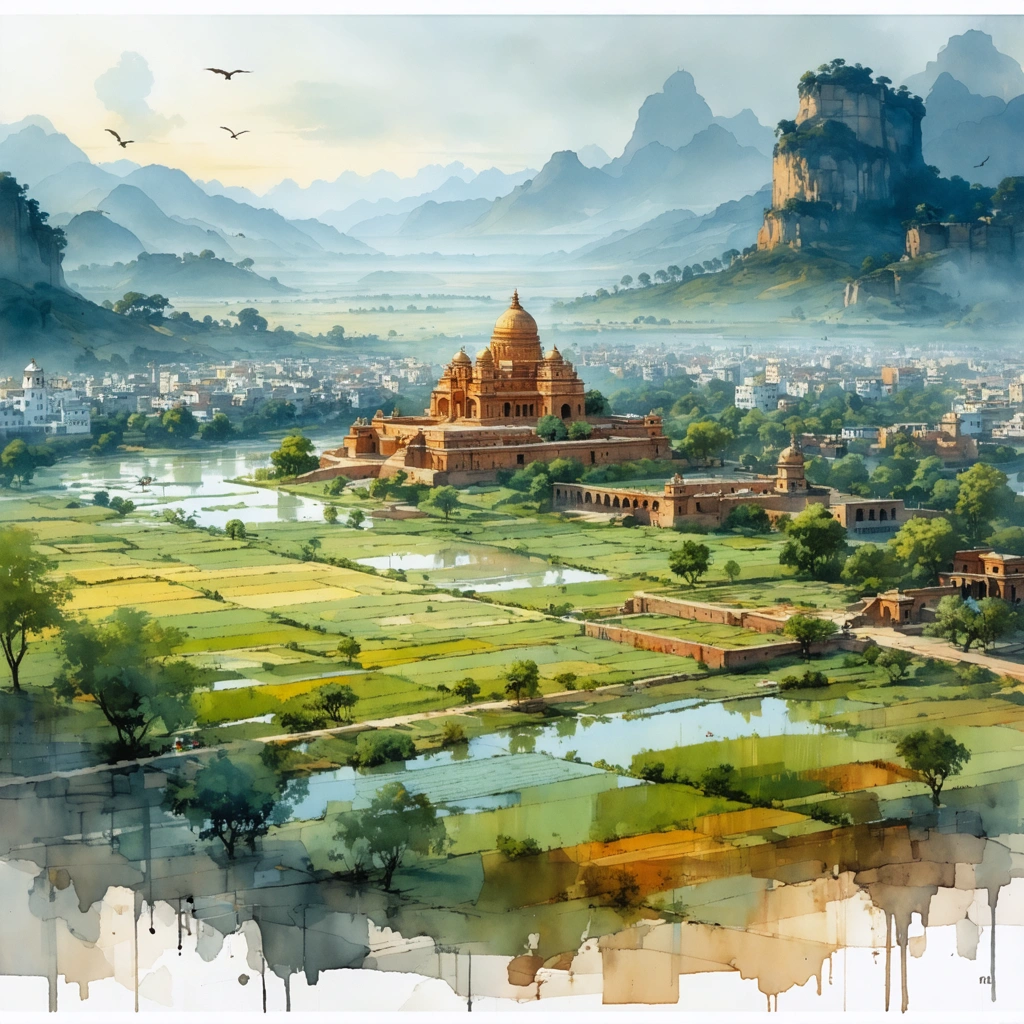
Unveiling the Mystique: Why Do Ancient Cities Matter Today?
Imagine walking through the dusty lanes of a city where every stone whispers stories of kings, warriors, and sages. Ancient cities are not just relics of the past; they are living archives, bearing witness to the evolution of culture, politics, and human ingenuity. For a country like India, whose roots run deep into millennia-old civilizations, these cities are the very backbone of its heritage.
Now, here’s a question that often intrigues history buffs and curious travelers alike: Hastinapur Kahan Hai? Or, in other words, where exactly is Hastinapur located? This is more than a mere query about geography; it’s an invitation to explore one of the most celebrated ancient cities that shaped Indian mythology and history. For those searching “Hastinapur Kahan Hai Map” or “Hastinapur Kahan Hai in Hindi,” the quest is a journey toward understanding the roots of the Mahabharata, the epic that resonates through Indian culture even today.
Yet, how often do we pause to appreciate how these ancient urban centers influenced the social fabric, art, and governance systems that continue to affect modern India? Despite their significance, many of these cities—and their stories—remain shrouded in mystery, buried under layers of time and forgetfulness. This disconnect can leave us feeling detached from a vital part of our identity.
Tracing the Footsteps: Hastinapur and Other Ancient Cities—A Journey Through Time
Hastinapur, often mentioned in ancient Indian texts, was the capital of the Kuru kingdom and is famously known as the seat of the Pandavas and Kauravas from the Mahabharata. But beyond mythology, where is Hastinapur actually located? The straightforward answer is that it’s situated in the modern Indian state of Uttar Pradesh, near the city of Meerut. Those searching for “Hastinapur Kahan Hai Map” will find it nestled in the fertile Gangetic plains, a region that has seen continuous human habitation for thousands of years.
The city’s significance transcends legend. Archaeological excavations have uncovered evidence of advanced urban planning and vibrant trade networks dating back to ancient times. This makes Hastinapur not just a city of myths but a real historical hub that shaped early Indian civilization.
But Hastinapur is just one jewel in a crown of ancient Indian cities that have molded the country’s heritage. Consider:
- Varanasi: Often called the oldest living city in the world, it’s a spiritual capital with a history stretching back over 3,000 years.
- Mathura: Known as the birthplace of Lord Krishna and a center of ancient art and culture.
- Harappa and Mohenjo-Daro: Though outside the current political borders of India, these Indus Valley Civilization cities have deeply influenced Indian history and identity.
Each city is a chapter in the vast narrative of India’s past, and understanding their geographical locations and cultural contexts helps us appreciate the immense tapestry of Indian heritage.
Why Knowing ‘Hastinapur Kahan Hai’ Matters More Than You Think
You might wonder why so many people search for “Hastinapur Kahan Hai in Hindi” or its English equivalents. The answer lies in the city’s symbolic weight. Hastinapur represents the crossroads of mythology, history, and archaeology. For students, scholars, and even casual enthusiasts, pinpointing its location is the first step to diving deeper into the epic stories and societal structures that once thrived there.
Moreover, connecting with these ancient cities fosters a sense of pride and belonging. It reminds us that India’s modern identity is intricately linked to the timeless legacies of places like Hastinapur. By mapping out these locations—both physically on a map and culturally in our collective memory—we reclaim a piece of our shared heritage.
Understanding where Hastinapur lies also encourages preservation efforts. When people know the exact spot of such historical gems, they become more invested in protecting and promoting them. This, in turn, ensures that the stories embedded in these cities continue to inspire generations to come.
Looking Ahead: Journeying Through India’s Ancient Urban Heritage
As we venture further into this article, we will explore how ancient cities like Hastinapur not only influenced mythology and literature but also shaped the socio-political landscape of their times. We’ll delve into their geography, archaeology, and cultural significance, answering questions like “Hastinapur Kahan Hai” with a broader lens that brings history alive.
Whether you’re a traveler planning your next cultural expedition, a student eager to connect with India’s past, or simply someone fascinated by ancient civilizations, this exploration promises to enrich your understanding. Together, we will uncover how these ancient cities are not just relics but living testimonials of India’s enduring heritage.
So, buckle up for a journey through time, place, and legend—a journey that starts with a simple question: Hastinapur Kahan Hai?

India’s Ancient Cities: Reflecting on the Ancient Cities Shaping India’s Heritage
India is a land steeped in history, and its ancient cities serve as living testaments to the rich cultural, spiritual, and political heritage that has shaped the nation over millennia. Among these cities, Hastinapur holds a special place, as it is intricately linked with the epic Mahabharata and the early dynastic history of northern India.
Where is Hastinapur Located? Understanding "Hastinapur Kahan Hai"
The question Hastinapur Kahan Hai translates to “Where is Hastinapur?” in Hindi, and it reflects the curiosity of many who want to locate this historically significant city on the map today. Hastinapur is situated in the Indian state of Uttar Pradesh, specifically in the Meerut district. It lies approximately 96 kilometers from the national capital, New Delhi, making it accessible for travelers and scholars alike.
Geographical Context: Hastinapur Kahan Hai Map
When searching for Hastinapur Kahan Hai Map, one can find that Hastinapur is positioned on the fertile plains of the Ganges-Yamuna Doab. This strategic location contributed to its prominence in ancient times as a center of power, culture, and religion. The city is surrounded by lush agricultural land and lies near the Ganges river basin, which provided sustenance and trade routes for its inhabitants.
Modern maps highlight Hastinapur’s proximity to key cities such as Meerut and Muzaffarnagar, making it a significant archaeological site for those interested in India’s early urban settlements and mythological history. Tourists often use GPS and online map services to explore the ruins and temples of Hastinapur, deepening their understanding of its role in Indian heritage.
Hastinapur Kahan Hai in Hindi: Exploring Local Perspectives
The phrase Hastinapur Kahan Hai in Hindi is commonly searched by Hindi-speaking audiences seeking detailed information about the city’s historical and cultural relevance. Locally, Hastinapur is not just a geographical location but a symbol of ancient Indian civilization, linked to the lineage of the Kuru dynasty as narrated in the Mahabharata.
In Hindi literature and folklore, Hastinapur is often described as the capital city of the Pandavas and Kauravas, the two royal families whose rivalry is central to the Mahabharata epic. This deep-rooted cultural significance makes the city a focal point for historians, archaeologists, and devotees alike.
The Historical Importance of Hastinapur and Its Influence on India’s Heritage
Hastinapur’s importance extends beyond mythology. Archaeological excavations have uncovered evidence of continuous habitation dating back to the Iron Age (around 1200 BCE), indicating that it was a major urban center in ancient India. This continuous settlement history provides valuable insights into the development of early Indian society, governance, and urban planning.
The city’s legacy includes:
- Political Hub: Hastinapur was the seat of the Kuru kingdom, one of the earliest known kingdoms in northern India, which played a crucial role in shaping the region’s political history.
- Cultural Nexus: It served as a center for Vedic learning and rituals, influencing religious practices and cultural traditions that persist today.
- Architectural Heritage: Remnants of ancient fortifications, temples, and water management systems reveal sophisticated urban planning.
Why Understanding Hastinapur’s Location Matters for Heritage Enthusiasts
Knowing Hastinapur Kahan Hai is fundamental for anyone interested in India’s ancient history for several reasons:
- Contextual Exploration: Visiting or studying Hastinapur allows for an immersive experience into the Mahabharata’s setting, connecting literary narratives with real-world geography.
- Preservation Efforts: Awareness of its location helps promote conservation and archaeological research, ensuring that this heritage site is protected for future generations.
- Educational Value: It serves as a practical case study for students and researchers exploring ancient Indian civilization, urban development, and historical geography.
How to Visit Hastinapur and What to Expect
For travelers interested in exploring the roots of India’s heritage, Hastinapur offers a unique blend of mythology and archaeology. The nearest major railway station is Meerut, with good road connectivity to Hastinapur.
Visitors can expect to see:
- Ancient ruins and archaeological sites maintained by the Archaeological Survey of India
- Temples dedicated to figures from the Mahabharata, including the Pandavas
- Local museums showcasing artifacts excavated from the region
- Guided tours that provide detailed narratives linking the city’s past with its present
Exploring Hastinapur offers a profound insight into how ancient cities have shaped India’s heritage, blending mythology with tangible history.
Conclusion: The Enduring Legacy of Hastinapur and Other Ancient Indian Cities
India’s ancient cities like Hastinapur are not just archaeological sites but living symbols of the country’s deeply layered heritage. Understanding Hastinapur Kahan Hai, examining its map, and appreciating its significance in Hindi and other languages helps connect millions of people to their cultural roots. These cities continue to inspire, educate, and remind us of the enduring legacy that forms the foundation of modern India.


